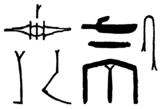Maapermin
| Maapermin in hieroglyphics | |||||
|---|---|---|---|---|---|
| Surname |
Maapermin (Maa aper Min) M3ʿ 3pr Mnw |
||||
|
Ink inscription with the name of Maapermin, on the right the characters for "Sed-Fest" |
|||||
Maapermin , actually Ma'a-aper-Min , is the name of a high ancient Egyptian official of the late 2nd dynasty , or the early 3rd dynasty . It is unclear exactly which kings he served. Maapermin's case is similar to that of his contemporary counterpart Inichnum .
supporting documents
Maapermin's name appears on numerous fragments of calcite - alabaster vessels found in the Great Galleries of the Djoser Complex in Saqqara . Other finds come from two private graves in Saqqara. These are short vessel inscriptions made of black ink , which were executed in italics ( hieratic ).
Term of office
The inscriptions on the vessel show that Maapermin held the title of “valet of the king”. This is a typical title and function title of royal family members of the early days. The inscriptions also show that Maapermin mainly participated in a Sedfest and was responsible for the care and maintenance of a Ka house . He shared this task with his colleague Inichnum .
Dating
Ilona Regulski and Peter Kaplony mention Maapermin's term in office during the reigns of Chasechemui and Netjerichet . Ilona Regulski also refers to comparisons of the ink inscription on Maapermins with that on finds from Abydos in the tomb of Chasechemui. Regulski rejects earlier assumptions on the part of Wolfgang Helck , who dated the ink inscriptions during the reign of King Ninetjer , on the grounds that certain fonts and spellings, as they appear in Maapermins and Inichnum's inscriptions, were not yet developed and in use during Ninetjer's lifetime.
Regulski uses certain hieroglyphs and their spelling in the hieratic script as the most important point of reference . Various characters under Ninetjer were executed in great detail in italics, but in the ink inscriptions of Maapermin and Inichnum, many characters are reproduced in a greatly simplified manner and sometimes reduced to rough lines. The conical hieroglyph Aa20 ( tied linen sack ; sound value aper ), for example, was still clearly conical in italics under Ninetjer, but from King Chasechemui it appears only as a straight line with a y-shaped split end. This is exactly the case with the markings on the Maapermin. Based on these comparison results, the ink inscriptions are now dated to the time of the kings Chasechemui to Sechemchet .
Significance for Egyptology
The Maapermin vessel inscriptions are of some importance to Egyptologists and historians. They not only provide valuable information and insights into the development of hieratic writing during the early days, they also contain possible evidence of a particularly obscure rulers, namely Horus Sa . The aforementioned Ka house that Maapermin looked after and supplied could have belonged to Horus Sa. However, since Sa's name never appears in a royal serech , its existence is already controversial and a reliable chronological assignment to the 2nd or 3rd dynasty has not yet been made.
dig
Maapermin's grave is unknown, Wolfgang Helck and J. Spencer suspect the mastabas S2429 and S3009 as possible resting places.
See also
literature
- Peter Kaplony: The inscriptions of the early Egyptian period. Volume I, Harrassowitz, Wiesbaden 1963.
- Pierre Lacau, Jan-Phillip Lauer: La Pyramide a Degrees. Volume IV: Inscriptions Gravees sur les Vases: Fouilles à Saqqarah. Service des antiquités de l'Égypte, Cairo 1936.
- Dilwyn Jones: An Index of ancient Egyptian titles, epithets and phrases of the Old Kingdom. Archaeopress, Oxford 2000, ISBN 1-84171-069-5 .
- Ilona Regulski: Second dynasty ink inscriptions from Saqqara paralleled in the Abydos material from the Royal Museums of Art and History in Brussels . In: Stan Hendrickx, RF Friedman, Barbara Adams, KM Cialowicz: Egypt at its origins. Studies in memory of Barbara Adams. Proceedings of the international conference "Origin of the State, Predynastic and Early Dynastic Egypt", Kraków, August 28th - September 1st, 2002 (= Orientalia Lovaniensia analecta . Volume 138). Peeters Publishers, Leuven (NL) 2004, ISBN 90-429-1469-6 , ( PDF file; 196 kB ).
Individual evidence
- ↑ P. Lacau, J.-P. Lauer: La Pyramide a Degrees. Volume IV, Cairo 1936, plates 10-11; Object 10.7.
- ↑ P. Lacau, J.-P. Lauer: La Pyramide a Degrees. Volume IV, Cairo 1936, plates 10-11; Object 10.8
- ↑ P. Lacau, J.-P. Lauer: La Pyramide a Degrees. Volume IV, Cairo 1936, p. 70.
- ↑ a b c d e Wolfgang Helck : Investigations on the Thinite Age (= Ägyptologische Abhandlungen. (ÄA) Vol. 45). Harrassowitz, Wiesbaden 1987, ISBN 3-447-02677-4 , p. 398.
- ↑ a b c d e Ilona Regulski: Second dynasty ink inscriptions from Saqqara paralleled in the Abydos material from the Royal Museums of Art and History in Brussels . Leuven (NL) 2004, pp. 953-959.
| personal data | |
|---|---|
| SURNAME | Maapermin |
| ALTERNATIVE NAMES | Maa-aper-min |
| BRIEF DESCRIPTION | ancient Egyptian official of the 2nd dynasty |
| DATE OF BIRTH | around 28th century BC Chr. |
| DATE OF DEATH | around 28th century BC Chr. |

